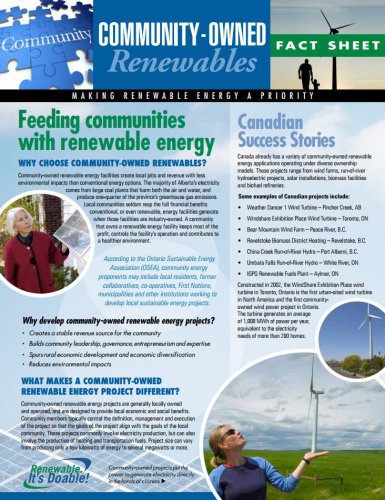Community-owned renewable energy facilities create local jobs and revenue with less environmental impacts than conventional energy options. The majority of Alberta’s electricity comes from large coal plants that harm both the air and water, and produce one-quarter of the province’s greenhouse gas emissions. Local communities seldom reap the full financial benefits conventional, or even renewable, energy facilities generate when those facilities are industry-owned. A community that owns a renewable energy facility keeps most of the profit, controls the facility’s operation and contributes to a healthier environment.
Why develop community-owned renewable energy projects?
- Creates a stable revenue source for the community
- Builds community leadership, governance, entrepreneurism and expertise
- Spurs rural economic development and economic diversification
- Reduces environmental impacts
Download the Community-Owned Renewables Fact Sheet
Canadian Success Stories Canada already has a variety of community-owned renewable energy applications operating under diverse ownership models. These projects range from wind farms, run-of-river hydroelectric projects, solar installations, biomass facilities and biofuel refineries. Some examples of Canadian projects include:
- Weather Dancer 1 Wind Turbine – Pincher Creek, AB
- Windshare Exhibition Place Wind Turbine – Toronto, ON
- Bear Mountain Wind Farm – Peace River, B.C.
- Revelstoke Biomass District Heating – Revelstoke, B.C.
- China Creek Run-of-River Hydro – Port Alberni, B.C.
- Umbata Falls Run-of-River Hydro – White River, ON
- IGPG Renewable Fuels Plant – Aylmer, ON
Constructed in 2002, the WindShare Exhibition Place wind turbine in Toronto, Ontario is the first urban-sited wind turbine in North America and the first communityowned wind power project in Ontario. The turbine generates an average of 1,000 MWh of power per year, equivalent to the electricity needs of more than 200 homes.





